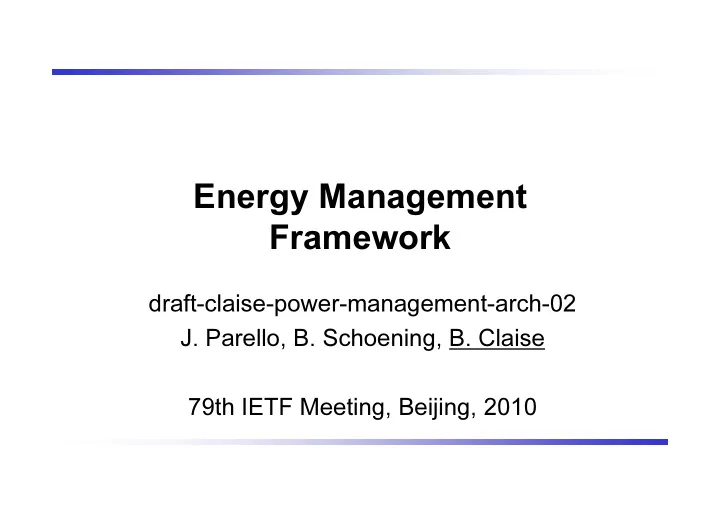

Energy Management Framework Framework draft-claise-power-management-arch-02 J. Parello, B. Schoening, B. Claise 79th IETF Meeting, Beijing, 2010
Charter: Documents 1. Requirements 6. Applicability Statement 2. Framework. 3. Energy- 4. Power 5. Battery aware and Energy MIB Networks Monitoring and Devices MIB MIB 2
Architecture: Overview of Scenarios � Use Case Scenarios � Switch with PoE endpoints � Switch with PoE endpoints + device(s) � Switch with Wireless Access Points Switch with Wireless Access Points � Building Gateway Device � Data Center Network � Power Consumption of UPS � Power Consumption of Battery-based 3
Architecture: Concept of Parent/Child The Parent/Child: 1. the parent reporting/aggregating the power for the end points 2. the parent potentially controlling the child power states (“how” not in scope) Justification: 1. Scaling issue if the NMS would control each child 2. Building Management System requires a proxy 4
Reference Model +---------------+ | NMS | - +-----+---+-----+ | | | | | | | S +---------+ +-------+ | N | | | M | | | P +---------------+ +------+-------+ | | Power Monitor | | Power Monitor | | | Parent 1 | ... | Parent N | - +---------------+ +---------------+ ||| (protocol ||| (protocol ||| Power source can be the parent Power source can be the parent out of ||| +-------------+---------+ (PoE) but no compulsory the scope)|||------| Power Monitor Child 1 | || +-----------------------+ || || +-------------+---------+ ||-------| Power Monitor Child 2 | | +-----------------------+ | | |-------- ... | | | +-------------+---------+ |--------| Power Monitor Child M | +-----------------------+ 5
Architecture: Concept of Power Levels Level ACPI Global/System State Name 1 G3, S5 Mech Off 2 G2, S5 Soft Off 3 G1, S4 Hibernate Non-operational 4 G2, S3 Sleep ( Save-to-RAM) states 5 G2, S2 Standby 6 G2, S1 Ready 7 G0, S0, P5 LowMinus 7 G0, S0, P5 LowMinus 8 G0, S0, P4 Low 9 G0, S0, P3 MediumMinus Operational states 10 G0, S0, P2 Medium 11 G0, S0, P1 HighMinus 12 G0, S0, P0 High G = Global state, S = System state, P = Performance state ACPI: Advanced Configuration and Power Interface 6
Architecture: Concept of Manufacturer Power Levels Manufacturer Power Level / Manufacturer Power Name 0 none 1 short Implementation : 2 tall Device 3 grande Manufacturer’s 4 venti Capability Power Level/Name Manufacturer Power Level / Name 1 / Mech Off 0 / none 2 / Soft Off 0 / none Interface : 3 / Hibernate 0 / none Mapped to 4 / Sleep, Save-to-RAM 0 / none 5 / Standby 0 / none the 6 / Ready 1 / short Standard 7 / LowMinus 1 / short Levels 8 / Low 1 / short 9 / MediumMinus 2 / tall 10 / Medium 2 / tall 11 / HighMinus 3 / grande 12 / High 4 / venti Manufacturer must be set from the Power Level 7
Architecture: Terminology � Power Monitor, Power Monitor Parent, Power Monitor Child, Power Monitor Meter Domain, Power Level, Manufacturer Power Level � Note: Important to agree on these terms, as they will be re-used in all the other documents 8
Architecture: Overview of New Concepts � Monitoring � Power Monitor Information � Power Monitor Meter Domain � Power Monitor Parent and Child � Power Monitor Levels � Power Monitor Context � Discovery Discovery � PoE -> Obvious � LLDP, LLDP-MED, CDP � Proprietary for non-IP protocols “communication specifications between the Power Monitor Parent and Children is out of the scope of this document” 9
TO DO � How to specify the notion of child capabilities, i.e. the capabilities that the Power Monitor Parents have with Power Monitor Children. Example: 1. Monitoring (only reporting) 2. Configuration power state 3. Configuration: power Example: on a PC, we can set power level a PC, we can set power level without knowing the power � Explain the 3 domains in more details: � Meter domain � Control domain � Power source domain 10
Open Issues � How should the WG consider IPFIX in this architecture? � Should transition states be tracked when setting a level. � Example: The configured level is set to Off from Example: The configured level is set to Off from High. The Actual level will take time to update as the device powers down. Should there be transitions shown or will the two variables suffice to track the device state. � Question for working group: Should implementation scenarios be incorporated in the architecture draft? 11
Conclusion � Still a couple of open issues � Which we have to solve soon � MIB dependencies � However, we would like to have this document considered as working item � Any feedback/question? 12
Backup slides Backup slides 13
Architecture: Power Levels � How many operational states do we need? Example1: an IP phone with an external dial pad and power savings (LCD off) � having three power modes (i.e., 9w, 12w, 14w) Example2: a Laptop PC with Windows 7 has 3 states: High Performance, Balanced, � and Power Saver. Example3: video camera, 4 levels (lower resolution, take samples) � Example4: PoE has 5 classes of power in IEEE 802.3at and � pethPsePortPowerClassifications � 14
Architecture: Power Levels 15
Recommend
More recommend